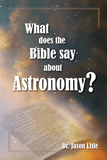
Chapter 4
The Bible and Modern Astronomy, Part 2
The Question of Extraterrestrial Life
The distinctiveness of the earth dovetails with a question that people often ask: “Are there extraterrestrial life-forms out there?” The question of life from other planets is a hot topic in our culture today. Science fiction movies and television shows often depict strange creatures from faraway planets, but these ideas are not limited merely to science fiction programming. Many secular scientists believe that one day we will actually discover life on other planets. There are even programs like SETI (the Search for Extra-Terrestrial Intelligence) that scan the heavens with powerful radio telescopes “listening” for signals from intelligent aliens. Unfortunately, many Christians have bought into the idea of extraterrestrial “alien” life without critically assessing such a belief in light of Scripture.
The idea of extraterrestrial life stems largely from a belief in evolutionism. Recall that in the evolution view, the earth is “just another planet”—one where the conditions just happened to be right for life to form and evolve. If there are countless billions of other planets in our galaxy, then surely at least a handful of these worlds have also had the right conditions. Extraterrestrial life is almost inevitable in an evolutionary worldview.
From a biblical perspective, extraterrestrial life does not seem reasonable.
However, the notion of alien life does not square well with Scripture. As previously discussed, the earth is unique. It is the earth that was designed for life (Isaiah 45:18), not the heavens. The other planets have an entirely different purpose than does the earth, and thus they are designed differently. In Genesis 1, we read that God created plants on the earth on day 3, birds to fly in the atmosphere and marine life to swim in the ocean on day 5, and animals to inhabit the land on day 6. Human beings are also made on day 6 and are given dominion over the animals, but where does the Bible discuss the creation of life on the “lights in the expanse of the heavens?” There is no such description, because the lights in the expanse were not designed to accommodate life. God gave care of the earth to man, but the heavens are the Lord’s (Psalms 115:16). From a biblical perspective, extraterrestrial life does not seem reasonable.

Imaginative artwork depicting alien life-forms.
Problems are multiplied when we consider the possibility of intelligent alien life. Science fiction programming abounds with “races” of people who evolved on other worlds. We see examples of “Vulcans” and “Klingons”—pseudo-humans similar to us in most respects but different in others.
As a plot device, these races allow the exploration of the human condition from the perspective of an outsider. Although very entertaining, such alien races are theologically problematic. Intelligent alien beings cannot be redeemed! God’s plan of redemption is for human beings: those descended from Adam. Let us examine the conflict between the salvation message, and the notion of alien life.
The Bible teaches that the first man (Adam) rebelled against God (Genesis 3). As a result, sin and death entered the world (Romans 5:12). We are all descended from Adam and Eve (Genesis 3:20) and have inherited from them a sin nature (Romans 6:6, 20). This is a problem: sin is a barrier that prevents man from being right with God (Isaiah 59:2), but God loves us (despite our sin) and provided a plan of redemption—a way to be reconciled with God.
After Adam and Eve sinned, God made coats of skins to cover Adam and Eve (Genesis 3:21). He therefore had to kill an animal(s). This literal action is symbolic of our salvation: an innocent Lamb (Christ—the Lamb of God) would be sacrificed to provide a covering for sin (John 1:29). In the Old Testament, people would sacrifice animals to the Lord as a reminder of their sin (Hebrews 10:3) and as a symbol of the One to come (the Lord Jesus) who would actually pay the penalty for sin.
The animal sacrifices did not actually pay the penalty for sin (Hebrews 10:4, 11). Animals are not related to us; their shed blood cannot count for ours, but the blood of Christ can. Christ is a blood relative of ours, since He is descended from Adam as are we; all human beings are of “one blood” (Acts 17:26). Furthermore, since Christ is also God, His life is of infinite value, and thus, His death can pay for all the sins of all people. That is why only the Lord himself could be our savior (Isaiah 45:21). Therefore, Christ died once for all (Hebrews 10:10).
The Redemption of ET?

Computer artwork depicting scientist’s impression of alien plants shaped like balloons.
When we consider how the salvation plan might apply to any hypothetical extraterrestrial (but otherwise human-like) beings, we are presented with a problem. If there were “Vulcans” or “Klingons” out there, how would they be saved? They are not blood relatives of Jesus, and so Christ’s shed blood cannot pay for their sins. One might at first suppose that Christ also visited their world, and lived and died there as well, but this is anti-biblical. Christ died once for all (1 Peter 3:18; Hebrews 9:27, 10:10). Jesus is now and forever both God and man; but He is not an “alien.”
One might suppose that alien beings have never sinned, in which case they would not need to be redeemed, but then another problem emerges: they suffer the effects of sin, despite having never sinned. Adam’s sin has affected all of creation—not just mankind. Romans 8:20–22 makes it clear that the entirety of creation suffers under the bondage of corruption. These kinds of issues highlight the problem of attempting to incorporate an antibiblical notion into the Christian worldview.
Of all the worlds in the universe, it was the earth that God himself visited
Extraterrestrial life is an evolutionary concept; it does not comport with the biblical teachings of the uniqueness of the earth and the distinct spiritual position of human beings. Of all the worlds in the universe, it was the earth that God himself visited, taking on the additional nature of a human being, dying on a cross, and rising from the dead in order to redeem all who would trust in Him. The biblical worldview sharply contrasts with the secular worldview when it comes to alien life. So, which worldview does the scientific evidence support? Do modern observations support the secular notion that the universe is teeming with life or the biblical notion that earth is unique?
Where Is everybody?

Artist illustration of Pluto, Charon, and the sun
So far, no one has discovered life on other planets or detected any radio signals from intelligent aliens. This is certainly what a biblical creationist would expect. Secular astronomers continue to search for life on other worlds, but they have found only rocks and inanimate matter. Their radio searches are met with silence. The real world is the biblical world, a universe designed by God with the earth at the spiritual focal point—not an evolutionary universe teeming with life.
When it comes to extraterrestrial life, science is diametrically opposed to the evolutionary mentality. We currently have no evidence of alien life-forms. This problem is not lost on the secular scientists. Allegedly, the atomic scientist Enrico Fermi was once discussing the topic of extraterrestrial life when he asked the profound question: “Where is everybody?” Since there are multiple billions of planets in our galaxy, and since in the secular view these are all accidents, it is almost inevitable that some of these had the right conditions for life to evolve, and if some of these worlds are billions of years older than ours, then at least some of them would have evolved intelligent life eons ago. The universe should therefore have countless numbers of technologically superior civilizations, any one of which could have colonized our galaxy ages ago. Yet we find no evidence of these civilizations: “Where is everybody?” This problem has become known as the “Fermi paradox.”
This paradox for evolution is a feature of creation. We have seen that the earth is designed for life. With its oceans of liquid water, a protective atmosphere containing abundant free oxygen, and a distance from the sun that is just right for life, earth was certainly designed by God to be inhabited. The other planets of the universe were not. From the sulfuric acid clouds of Venus to the frozen wasteland of Pluto, the other worlds of the solar system are beautiful and diverse, but they are not designed for life.
Why the hype?
In the 1990s, the television series The X-Files entertained millions of fans with stories of aliens, government conspiracies, and one dedicated FBI agent’s relentless search for truth. The show’s motto, “The truth is out there” is a well-known phrase for sci-fi fans. Why is there such hype surrounding the notion of extraterrestrial life? Why is science fiction programming so popular? Why does SETI spend millions of dollars searching for life in outer space?

The Helix Nebula (as it appears in ultraviolet light) is an expanding shell of hydrogen and helium gas. The central spot is a white dwarf—an extremely hot, dense object about the size of Earth. White dwarfs are often found at the center of such nebulae. They are thought to be the collapsed remnant of the star that produced the Nebula.

Cassiopeia A is a supernova remnant—the result of an exploding star. It is located about 10,000 light-years away in the constellation Cassiopeia. Although it is thought to be more recent than Kepler’s supernova of 1604, this supernova appears to have gone almost unnoticed, perhaps because it was very faint. The sharp turquoise dot in the center is a neutron star. It is a hot, extremely compressed mass (no larger than a city) and is thought to be the collapsed core of the exploded star.
The discovery of intelligent extraterrestrial life would certainly be seen as a vindication of evolutionism; it is an expectation from a naturalistic worldview. The desire to meet aliens (especially intelligent, technologically advanced ones) seems much more deeply felt than merely to vindicate evolutionary predictions. What is the real issue? I’ve heard a number of different answers from secular astronomers.
In some cases, a belief in ETs may stem from a feeling of cosmic loneliness: “If there are aliens, then we would not be alone in the universe.” In many cases it comes from an academic desire to learn the mysteries of the universe; a highly developed alien race might have advanced knowledge to pass on to us. Perhaps such knowledge is not merely academic; the hypothetical aliens may know the answers to fundamental questions of existence: “Why am I here? What is the meaning of life?” And so on. An advanced alien race might have medical knowledge far exceeding our own: knowledge which could be used to cure our diseases. Perhaps their medical technology would be so far advanced that they even hold the secret of life and death; with such incredible medical knowledge, perhaps human beings would no longer have to die—ever.
In a way, a belief in extraterrestrial life has become a secular replacement for God. God is the one who can heal every disease. God is the one in whom all the treasures of wisdom and knowledge are deposited (Colossians 2:3). God is the one who can answer the fundamental questions of our existence. God alone possesses the gift of eternal life (John 17:3). It is not surprising that the unbelieving scientist would feel a sense of cosmic loneliness, having rejected his Creator, but we are not alone in the universe; there is God. God created us for fellowship with Him; thus we have an in-built need for God and for purpose. Although human beings have rejected God (in Adam, and by our own sins as well), our need for fellowship with Him remains.
When I think of the majority of intelligent scientists who have studied God’s magnificent creation but have nonetheless rejected that God and have instead chosen to believe in aliens and millions of years of evolution, I am reminded of the words of Scripture. Romans 1:18–25 reveals that a rejection of God in favor of naturalism is not a new practice. God’s invisible qualities (His eternal power and divine nature) are clearly revealed in the natural world so that there is no excuse for rejecting God (Romans 1:20) or suppressing the truth about God (Romans 1:18). The thinking of man apart from God is nothing more than futile speculations (Romans 1:21). Exchanging the truth of God (such as creation) for a lie (such as evolution), and turning to a mere creature (such as hypothetical aliens) for answers is strikingly similar to what is recorded in Romans 1:25.
When we start from the Bible, the evidence makes sense. The universe is consistent with the biblical teaching that the earth is a special creation. The magnificent beauty and size of a universe which is apparently devoid of life—except for one little world where life abounds—is exactly what we would expect from a biblical worldview. The truth is not “out there”; the truth is in there—in the Bible! The Lord Jesus is the truth (John 14:6). So when we base our thinking on what God has said in His Word, we find that the universe makes sense.
Creation In-depth
What about UFOs?
Sometimes after I speak on the topic of extraterrestrial life, someone will ask me about UFOs. A “UFO” (unidentified flying object) is just that—an object seen in the sky that is unidentified to the person seeing it. People often want me to explain a sighting of some unknown flying object which they (or often a friend) have claimed to see. (Sometimes the implication is that if I can’t explain it, it somehow proves that it must be an alien spacecraft; but such reasoning is completely vacuous.) These kinds of questions are unreasonable. It is one thing to be asked to interpret evidence that we have, but it is unrealistic to ask someone to interpret undocumented second- or third-hand stories with no actual evidence available for inspection.
There is no doubt that some people sincerely have seen things in the sky that they do not understand. This is hardly surprising since there are lots of things “up there” which can be misunderstood to people not familiar with them. These include Venus, satellites, the international space station, the space shuttle, rockets, Iridium flares, man-made aircraft, internal reflections, meteors, balloons, fireflies, aurorae, birds, ball lightning, lenticular clouds, parhelia, etc. However, a person unfamiliar with these would see a “UFO,” since the object is “unidentified” to him or her. It is how people interpret what they see that can be questionable.
Remember that we always interpret evidence in light of our worldview. It is therefore crucial to have a correct, biblical worldview. The fallacious worldview of atheism/naturalism may lead someone to draw erroneous conclusions about what they see. From a biblical worldview, we expect to occasionally see things that are not easily explained, since our minds are finite: but UFOs are not alien spacecraft, and of course there is no tangible evidence to support such a notion.
Taking Back Astronomy
Dr. Lisle communicates the truths of creation and the fallacies of evolution with authority and enthusiasm. In this richly illustrated book, Lisle debunks the most widely accepted teachings about the idea of evolution. Readers are given solid answers to many questions, including the speed of light, the big bang, extraterrestrials, the reliability of the Bible regarding astronomy, and more.
Read Online Buy BookRecommended Resources

Answers in Genesis is an apologetics ministry, dedicated to helping Christians defend their faith and proclaim the good news of Jesus Christ.
- Customer Service 800.778.3390
- © 2024 Answers in Genesis





